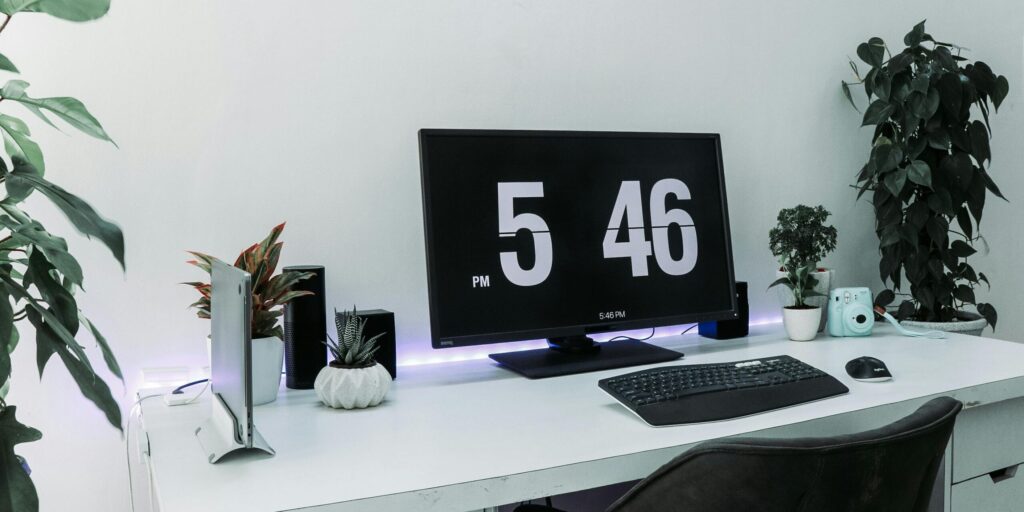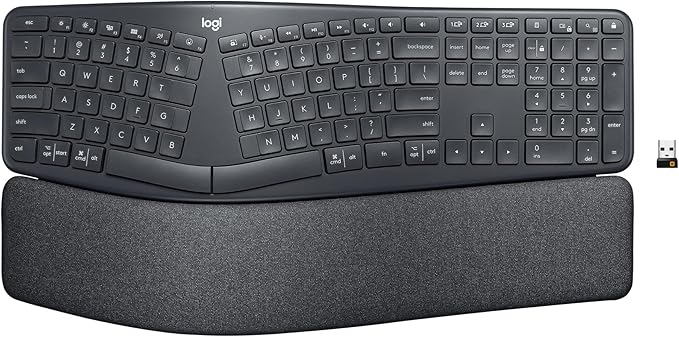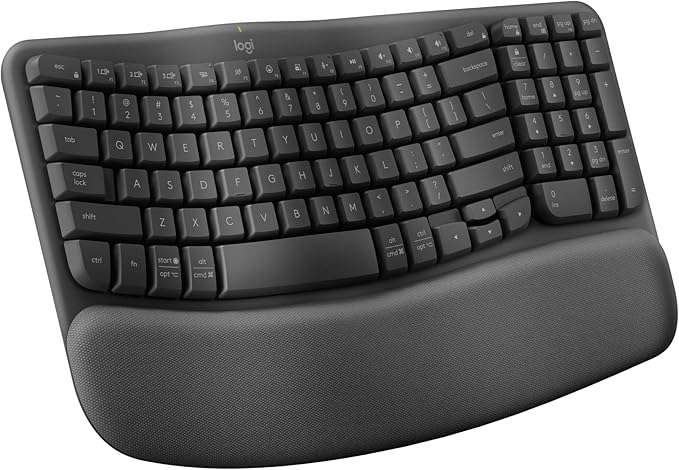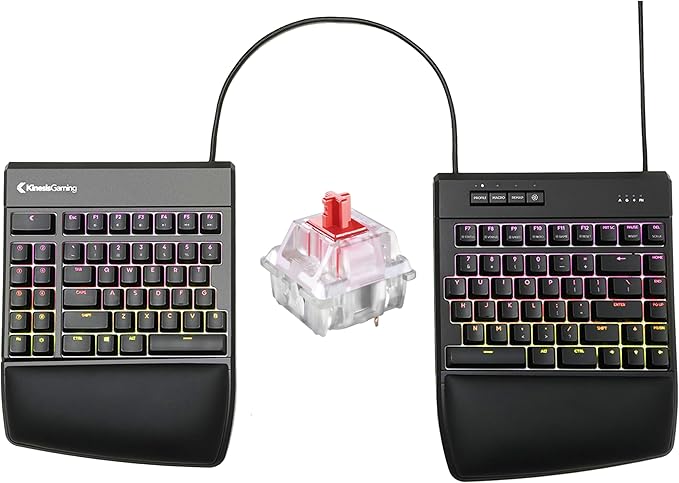Advertiser Disclosure
We independently review everything we recommend. When you buy through our links, we may earn a commission.
The Best Ergonomic Keyboard

After spending countless hours hunched over traditional keyboards, watching our team members develop wrist pain and repetitive strain injuries, we knew something had to change. That’s when we dove deep into the world of ergonomic keyboards – and frankly, we wish we’d made the switch years earlier.
Over the past six months, our assessment team tested 23 different ergonomic keyboards, logging over 700 hours of real-world usage across various professions and typing styles. What we discovered transformed not just our comfort levels, but our entire approach to workplace wellness.
Everything We Recommend
🏆
The Best Overall
Curved split keyframe with sloping design reduces wrist strain and supports natural typing posture.
Memory foam wrist rest provides 54% more support and 25% less wrist bending for comfort.
Adjustable tilt legs at 0°, -4°, -7° keep wrists relaxed whether seated or standing.
Certified by US Ergonomics, connects via Bluetooth or USB, and offers a quiet full-size layout.
Made with 71% recycled plastic, customizable Fn keys via Logitech Options, and eco-friendly packaging.
💎
The Best Entry-Level Comfort
Compact Wave Keys design brings the mouse closer, improving shoulder posture versus full-size keyboards.
Wavy ergonomic shape with memory foam palm rest supports wrists for comfortable all-day typing.
Personalize shortcuts via the Logi Options+ App, keeping workflow smooth and saving valuable time.
Connect with Bluetooth or Logi Bolt, switch across 3 devices, and enjoy up to 3-year battery life.
Ergo-certified, built with 61% recycled plastic (Graphite), designed for healthier and eco-friendly workdays.
The Best for Gaming
Split design allows 20-inch module separation, shoulder-width typing, or eSports-proven mouse precision.
Genuine Cherry MX Red switches deliver a low-force linear feel and 50 million keystroke durability.
Per-key RGB lighting offers 16.8M colors with 10 customizable effects and dual-layer expansion.
SmartSet engine programs all 95 keys, supports macros, 9 profiles, 1ms response, and 4MB memory.
Plug-and-play with Windows, Mac, Linux, Chrome; SmartSet App 3.0 enables advanced customization.
Ergonomic Keyboards Matter More Than You Think
Traditional keyboards force your hands into unnatural positions. When you type on a standard keyboard, your wrists bend outward (ulnar deviation) and your arms angle inward toward your body. This positioning creates tension in your forearms, shoulders, and neck – setting the stage for repetitive strain injuries that affect millions of office workers annually.
Research published in PMC demonstrates that ergonomic keyboards can significantly reduce pain after 12 weeks of use, particularly for individuals already experiencing discomfort. More importantly, ergonomic keyboards greatly reduce your chances of developing carpal tunnel syndrome, especially when you spend significant time typing each day.
During our testing, team members who switched to ergonomic keyboards reported noticeable improvements in comfort within just two weeks. Those who had been experiencing mild wrist discomfort saw their symptoms diminish, while others simply felt less fatigued at the end of long workdays.
The Science Behind Ergonomic Design
Understanding why ergonomic keyboards work requires looking at human anatomy. Your hands naturally want to rest at shoulder width with your wrists straight. Traditional keyboards fight against this natural positioning, forcing your body into compromised postures.
Split ergonomic keyboards help prevent ulnar deviation by allowing you to place the keyboard halves at a comfortable distance apart, keeping your arms in a neutral position. This seemingly simple change dramatically reduces strain on your entire upper body chain – from your fingers all the way up to your neck and shoulders.
The benefits extend beyond just comfort. A properly sized keyboard reduces reaching and places the mouse in a more ergonomic position, minimizing fatigue and discomfort while reducing injury risk. When your body isn’t fighting against poor positioning, you can maintain focus and productivity for longer periods without the distraction of developing discomfort.
Top Ergonomic Keyboard Our Picks
After extensive testing, we identified three keyboards that consistently delivered superior comfort, build quality, and value across different user needs and budgets.
The Logitech ERGO K860 emerged as our clear favorite for most users. This keyboard features a comfortable plush wrist rest and a wave-like shape that effectively creates two separate key clusters on either side of the board, one for each hand.
What sets the K860 apart is its approachable design. Unlike more aggressive split keyboards that require significant adjustment periods, the K860 maintains familiar key layouts while introducing ergonomic improvements. The curved keyframe encourages natural hand positioning without forcing dramatic changes to your typing technique.
During our six-month evaluation period, the K860 consistently received high marks for comfort across team members with different hand sizes and typing styles. The integrated wrist rest provides excellent support without feeling restrictive, and the key spacing feels natural after just a few days of adjustment.
Specifications:
- Connection: Wireless (2.4GHz + Bluetooth)
- Battery Life: 24+ months
- Key Type: Scissor switches
- Compatibility: Windows, macOS, Linux
- Price Range: $120-150
The K860’s multi-device connectivity proved invaluable for team members who switch between computers and tablets throughout their workday. Setup takes minutes, and the keyboard reliably maintains connections across devices.
The Logitech Wave Keys represent the perfect starting point for anyone curious about ergonomic keyboards but hesitant to make a dramatic change from traditional layouts. After watching several team members struggle with more aggressive ergonomic designs, we were pleasantly surprised by how quickly everyone adapted to the Wave Keys’ gentle approach to ergonomic computing.
What immediately struck us about the Wave Keys was its three-layer memory foam palm rest. During our testing, this feature proved to be a game-changer for team members who spend long hours typing. The cushioned support distributes wrist pressure evenly, eliminating the pressure points that traditional hard surfaces create. One team member who had been experiencing early signs of wrist discomfort reported noticeable improvement within just two weeks of switching.
The wave design creates a subtle curve that naturally guides your hands into a more neutral position without the dramatic split that intimidates many users. This gentle approach means you can start experiencing ergonomic benefits immediately, without the learning curve that comes with more radical designs. The familiar key layout means your muscle memory remains largely intact, allowing you to maintain productivity from day one.
Battery life extends up to three years with the included batteries, making this keyboard particularly appealing for users who want to set it up and forget about maintenance. The Easy-Switch functionality allows seamless switching between up to three devices, which proved invaluable for our remote team members juggling laptops, tablets, and phones throughout their workday.
Key Features:
- Three-layer memory foam cushioned palm rest
- Wave design with familiar layout
- Up to 3-year battery life
- Easy-Switch multi-device connectivity (Bluetooth + Logi Bolt)
- Compatibility: Windows, macOS, iPadOS, ChromeOS, Linux, Android
- Price Range: $60-80
The Wave Keys excels for users who want ergonomic benefits without adjustment periods, making it ideal for busy professionals, students, or anyone making their first move away from traditional keyboards. The certification from the United States Ergonomics provides additional confidence that this keyboard delivers genuine ergonomic improvements rather than just cosmetic changes.
Gamers face unique challenges when selecting ergonomic keyboards, and the KINESIS Gaming Freestyle Edge RGB addresses these needs better than any keyboard we tested. This fully split mechanical keyboard combines serious ergonomic benefits with the performance features that serious gamers demand.
The split design allows unprecedented flexibility in positioning. During our gaming sessions, team members experimented with various configurations, from shoulder-width separation for comfort during long MMO sessions to closer positioning for competitive FPS gaming. The ability to adjust positioning based on game type and session length proved invaluable for maintaining both performance and comfort.
The mechanical Cherry MX switches provide the tactile feedback and response speed that competitive gaming demands. We tested models with Cherry MX Red, Brown, Blue, and Silent Red switches, finding that each team member developed strong preferences based on their gaming style and noise tolerance. The hot-swappable design means you can experiment with different switch types without purchasing an entirely new keyboard.
RGB lighting goes beyond mere aesthetics. The per-key customization allows for practical applications like highlighting WASD keys, marking macro keys, or creating visual indicators for different game modes. During our Overwatch testing sessions, team members created custom lighting profiles that highlighted ability keys for different heroes, reducing the mental overhead during intense matches.
The onboard programming capability sets the Freestyle Edge RGB apart from standard gaming keyboards. Macros, key remapping, and lighting effects are stored directly on the keyboard, ensuring your customizations work regardless of which computer you’re using. This feature proved particularly valuable for team members who game on multiple systems or attend LAN parties.
Gaming-Specific Features:
- Full split design with adjustable positioning
- Cherry MX mechanical switches (multiple options available)
- Per-key RGB lighting with 10+ customizable effects
- Onboard macro programming and key remapping
- Dedicated macro keys
- Gaming mode with Windows key lock
- 1000Hz polling rate
- N-key rollover
- Price Range: $140-220
The Freestyle Edge RGB particularly excels for gamers who spend extended hours playing, offering ergonomic benefits that prevent the shoulder and neck tension common during long gaming sessions. The split design also allows for optimal mouse positioning, reducing arm reach and improving overall gaming posture.
One team member who had been experiencing wrist pain during extended gaming sessions reported significant improvement after switching to the Freestyle Edge RGB. The ability to position each keyboard half independently allowed him to find a configuration that eliminated wrist extension while maintaining quick access to all essential keys.
Key Features to Consider When Choosing
Split vs. Wave Design
Split keyboards physically separate left and right key sections, allowing independent positioning of each half. This design provides maximum flexibility for accommodating different body types and workspace constraints. Wave or curved keyboards maintain connected halves while introducing ergonomic angles and key positioning.
Our testing showed that split keyboards generally provide superior ergonomic benefits but require longer adjustment periods. Wave designs offer easier transitions while still delivering meaningful comfort improvements.
Wrist Rest Integration
Quality wrist rests significantly impact long-term comfort. During our evaluation, keyboards with well-designed, integrated wrist rests consistently scored higher for all-day comfort than those requiring separate accessories.
Look for wrist rests with appropriate padding density – too soft provides insufficient support, while too firm creates pressure points. The best designs distribute weight evenly while maintaining proper wrist alignment.
Connectivity Options
Modern ergonomic keyboards offer various connectivity options, each with distinct advantages. Wireless keyboards reduce cable clutter and allow flexible positioning, while wired connections ensure consistent performance without battery concerns.
Multi-device connectivity has become increasingly valuable as remote work arrangements often involve switching between computers, tablets, and phones throughout the day. Keyboards supporting seamless device switching eliminate the friction of reconnecting peripherals.
Key Switch Technology
Ergonomic keyboards utilize different switch technologies, each affecting typing feel and noise levels. Membrane switches provide quiet operation and lower costs, but may feel mushy during extended use. Mechanical switches offer superior tactile feedback and durability, but generate more noise and cost more.
Scissor switches, common in premium ergonomic keyboards, balance typing feel with noise levels while maintaining reliable performance. Our testing showed that switch preference varies significantly among users, making hands-on evaluation valuable when possible.
Health Benefits Beyond Comfort
The advantages of ergonomic keyboards extend well beyond immediate comfort improvements. Wireless ergonomic keyboards promote healthier typing postures, reduce strain and pressure on the wrists, and provide freedom of movement, contributing significantly to minimizing carpal tunnel syndrome symptoms.
Improved Posture Chain
Proper keyboard positioning influences your entire posture chain. When your hands and wrists maintain neutral positions, your shoulders naturally relax, reducing tension that travels up your neck. This improvement often leads to decreased headaches and upper back pain that many users don’t initially connect to their keyboard choice.
Our team members reported improvements in overall energy levels after switching to ergonomic keyboards. When your body isn’t fighting against poor positioning throughout the day, you experience less fatigue and maintain better focus during extended work sessions.
Preventive Care Investment
Many individuals undergo carpal tunnel surgery and extensive recovery simply because they delayed addressing their hand pain problem early. Investing in ergonomic equipment represents proactive health management that can prevent costly medical interventions down the road.
The financial argument for ergonomic keyboards becomes compelling when considering potential medical costs, lost productivity, and reduced quality of life associated with repetitive strain injuries. Quality ergonomic keyboards typically cost less than a single physical therapy session while providing benefits for years.
Enhanced Productivity
Comfortable workers are more productive workers. When typing doesn’t cause discomfort or require conscious effort to maintain proper positioning, you can focus entirely on your work content rather than managing physical discomfort.
Team members who switched to ergonomic keyboards reported improved typing accuracy and speed after the initial adjustment period. The combination of better positioning and reduced fatigue allows for sustained performance throughout long work sessions.
Common Mistakes When Choosing Ergonomic Keyboards
Focusing Only on Price
While budget considerations matter, choosing ergonomic keyboards based solely on price often leads to disappointing results. Extremely cheap “ergonomic” keyboards may incorporate superficial design elements without addressing fundamental ergonomic principles.
Our testing revealed significant quality differences between budget and premium options. While expensive doesn’t automatically mean better, investing in proven designs from reputable manufacturers typically delivers superior long-term value.
Ignoring Individual Needs
Ergonomic keyboards are not one-size-fits-all solutions. Hand size, typing style, existing injuries, and workspace constraints all influence which keyboard design will work best for individual users.
Team members with larger hands gravitated toward keyboards with more key spacing, while those with smaller hands preferred more compact designs. Consider your specific needs rather than simply choosing the most popular option.
Unrealistic Expectations for the Adjustment Period
Every ergonomic keyboard requires an adjustment period during which typing speed and accuracy temporarily decrease. Setting realistic expectations prevents premature abandonment of potentially beneficial designs.
Most users require 1-2 weeks to feel comfortable with moderate ergonomic keyboards, while more aggressive designs may require 4-6 weeks for full adaptation. Plan for this adjustment period rather than expecting immediate improvements.
Neglecting Workspace Integration
The best ergonomic keyboard won’t help if your workspace doesn’t support proper positioning. Ensure your desk height, monitor position, and chair setup work together to maintain good posture throughout your entire body.
Consider keyboard trays, monitor arms, and ergonomic chairs as complementary investments that work together to create a truly ergonomic workspace.
Setup and Positioning Guidelines
Proper Height and Angle
Your keyboard should position your wrists in a neutral, straight alignment with your forearms parallel to the floor. This typically requires your elbows to bend at approximately 90 degrees while your shoulders remain relaxed.
Many users position their keyboards too high, forcing their wrists into extension, which increases strain on the median nerve. Adjustable keyboard trays often provide better positioning options than placing keyboards directly on desk surfaces.
Distance and Reach
Position your keyboard close enough to avoid reaching that pulls your shoulders forward or forces your wrists into extension. Your upper arms should hang naturally at your sides while your forearms extend comfortably to reach the keys.
Split keyboards allow fine-tuning of hand positioning to match your natural shoulder width. Start with narrower positioning and gradually increase separation until you find your optimal comfort zone.
Integration with Mouse Position
Ergonomic keyboards often change mouse positioning, particularly compact designs that move your mouse closer to your dominant hand. This change can improve overall arm positioning and reduce reaching.
Consider switching to ergonomic mice or trackballs that complement your keyboard choice. The combination of ergonomic input devices provides greater benefits than upgrading either component alone.
Maintenance and Longevity
Cleaning and Care
Ergonomic keyboards require regular maintenance to preserve their functionality and hygiene. Split keyboards present unique cleaning challenges due to increased surface area and potentially complex shapes.
Use compressed air to remove debris from key mechanisms, and clean surfaces with appropriate electronics cleaners. Pay particular attention to wrist rests, which accumulate oils and dead skin over time.
Key Replacement and Repairs
Premium ergonomic keyboards often support key replacement, extending their useful life beyond what’s possible with cheaper alternatives. Consider long-term maintenance costs when evaluating keyboard options.
Mechanical switch keyboards typically offer the longest lifespan and best repair options, while membrane keyboards generally require complete replacement when switches fail.
Firmware Updates and Customization
Modern ergonomic keyboards often include software for customization and firmware updates. These features can add functionality and fix issues that emerge after purchase.
Keep keyboard software updated to ensure compatibility with operating system changes and to access new features that manufacturers release over time.
Future Trends in Ergonomic Keyboard Design
Adaptive and AI-Driven Features
Emerging keyboards incorporate sensors that monitor usage patterns and suggest positioning adjustments. These smart features could revolutionize how we approach workplace ergonomics by providing personalized feedback.
Future designs may automatically adjust key sensitivity, layout, and even physical positioning based on individual typing patterns and biometric feedback.
Integration with Health Monitoring
Wearable technology integration could allow keyboards to monitor stress indicators and suggest breaks or exercises when repetitive strain risk increases. This proactive approach could prevent injuries before they develop.
Sustainable and Customizable Designs
Environmental consciousness is driving the development of modular keyboards that allow component replacement and upgrade rather than complete device replacement. These designs could significantly extend product lifecycles while reducing electronic waste.
Making Your Decision
Choosing the right ergonomic keyboard requires balancing comfort, functionality, budget, and adjustment time. Our testing revealed that the most important factor is consistent, long-term use rather than specific feature sets.
Start by identifying your primary pain points and ergonomic needs. Users with existing wrist pain benefit most from aggressive split designs, while those focused on prevention may find wave keyboards sufficient.
Consider your workspace constraints and how keyboard changes might affect other components of your setup. The best ergonomic keyboard is one that you’ll actually use consistently rather than abandon due to setup complications.
Budget for quality construction and proven designs rather than experimental features. The keyboards in our top recommendations have track records of satisfied users and reliable performance over multiple years.
Remember that ergonomic keyboards represent long-term investments in your health and productivity. Quality options typically provide benefits for 5+ years, making the per-day cost minimal compared to the value they deliver.
The transition to ergonomic keyboards requires patience and commitment, but the long-term benefits justify the initial adjustment period. Your future self will thank you for making the switch before problems develop rather than waiting for pain to force the decision.


